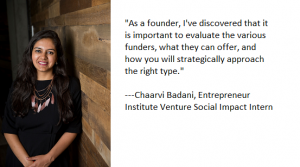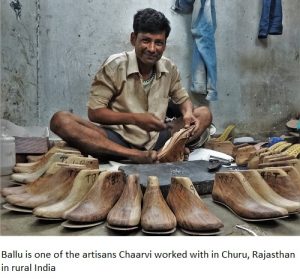I remember the first pitch I ever made to a venture capitalist to raise funds for my social enterprise. As the co-founder of a company that worked to increase livelihood opportunities for shoemaking artisans in rural India, I spent 30 minutes talking about the problem we were trying to solve, the artisans we’d met, and how enthused we were about this company. We’d just designed our first few pairs of shoes, sold to our first customers, and shared our profits with the artisans! And on the flipside, the investor kept asking us about our profit margins, unit economics and projections. These were things we’d kind of thought about, but hadn’t fully formulated. At the end of the meeting, us founders, and the investor left feeling like this was just a terrible fit.

When I mentioned this incident later to my mentor, she was quick to point out we were not in a stage to get funding from an investor. She said this like it was the most obvious thing! But that got me wondering, who should we approaching, and how do I choose who’s the right funder for me? And most importantly, where can I find that information?
It’s true that fundraising is the most important work of a start-up, apart from their actual mission itself. There are a variety of funders who can add value to the company based on stage of your startup. Additionally, each funder looks for different things when providing funding, making it harder to appeal to so many. As a founder, I’ve found that it is important to evaluate the various funders, what they can offer, and how you will strategically approach the right type.
- If you have an idea…
This is the gritty dorm-room stage of the startup, where you want to focus on researching the market, understanding the customers’ pains and validating your idea with field and desk work. Ideally, this is called the pre-seed stage, and the usual ‘funding’ rounds are around $50K.
There are limited options here for funding. The easiest (not literally) is to bootstrap if you think you have the sufficient funds to pull this through. This option depends entirely on your cash flow and liquidity. This is also the common time to raise from friends and family who believe in your idea and you! While this gives you some relief in terms of your cash flow, you must be careful about what you promise (or not) to people who invest – is it a stake in the company in the future? Is it a portion of the revenues? Or some first free products?
Today, crowdfunding through Kickstarter, Indiegogo and many more are exciting, new ways to engage with potential customers, build a brand and raise some money! Each crowdfunding platform has different details that determine how you will receive the funding, how much of it you will receive (especially in the event you don’t raise your target). But be careful about what you promise your funders – I’ve seen many entrepreneurs over-promise free samples to funders in a few months and under-deliver.

- If you have the beginnings of a product and sold a few as well…
This is exactly where I was in my journey when I began looking for funding. This is called the seed stage, where you have identified the problem, found the right product and maybe sold to the first few customers (paid or unpaid). With this funding, you want to scale your production, build a strategy to reach customers and start building the team. Investors ideally look for a founder-market fit at this point, which means they want to know if you are the right founder to tackle this problem and build this company. The ideal funding rounds are $100K up to $1M, based on the market you are operating in. Unfortunately, this is famously called the “valley of death,” where many great ideas fail because of lack of funding!
But thankfully, there are many options for funding here. Incubators and accelerators are plentiful today and the best ones offer growth services along with their money (think: networks, marketing, sales, measurement). Most incubators have sector and geography focus, which determines their networks and services. Additionally, some large incubators have common terms they sign with all the companies. For example, Y Combinator invests $150K through a post-money safe for 7% at conversion in all the companies they work with. In some cases, there are VC investors who invest in seed stage companies, like Clean Energy Trust and Launch Capital.
Based on your sector and geography, many large governmental foundations fund early-stage companies. Think the US Department of Agriculture, National Science Foundation etc. Additionally, foundations and philanthropic investors are increasingly focusing their funding on for-profit startups, like the Gates Foundation and Draper Richards Kaplan Foundation. These are good options for undiluted funding at this stage.
This is not to say that you must take any penny that comes your way. The early investors can make or break the business – with their approach to growth, the attitudes of communication and vision for the company. It’s ok to be picky (and in fact, I’d encourage it)! It is important to be strategic about: what value-add can the investor provide to your company, does she/he have strong expertise or networks in the sector and does she/he represent a company that would help open more funding doors in the future among many other considerations!
- If you’ve sold to many customers and are looking to scale…
This is, unfortunately, where I thought I was in my startup phase in that first meeting! Called the Series A funding round, a typical check-size starts at $1M. At this stage, you have established a working business model and sales cycle, assembled a strong team, and are looking to fund your growing production costs. This is the price round where the investors look to take a stake in the company for the capital invested.
This is the ideal time to seek funding from venture capitalists. If you are targeting VC funding, it is important to do a lot of research on the investor’s focus areas: stage, sector and geography, are they currently investing, do you see companies like yours in their portfolio? Ideally, you want to start meeting VCs much before you need to raise capital – this will give you an opportunity to build a strong relationship while evaluating their potential value-add to your company. I cannot stress enough how important it is to choose investors whose vision for the company is similar to yours, and whose style you can feel comfortable with.
So in short, there are many funding options based on the stage of your startup. Each funding process is different: each requires different marketing skills, have varied timelines and timeframes, and different evaluation factors. There is no one ‘ideal’ fundraising path or partner – it’s up to you to choose the one that suits you the best!
If I had someone teach me this before my very first meeting, it would’ve saved me a lot of time, money spent on coffee and heartache! I would’ve learned that, at that stage, an incubator would have maybe been an ideal choice for me. These are some of the tips I wish someone had told me before I met that first investor, and often times, things I wish entrepreneurs thought about before they approach me for funding!

